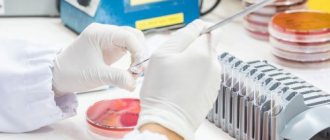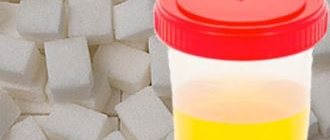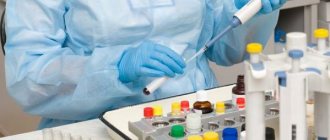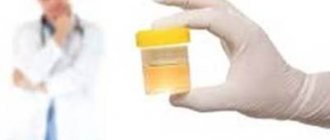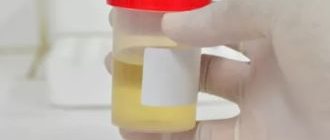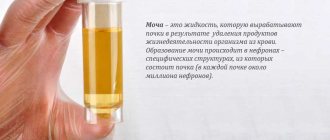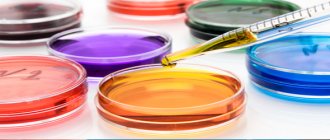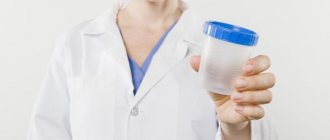Urinalysis is often prescribed for infants. This is one of the stages of a routine preventive examination; it helps to diagnose a number of diseases. Young parents need to understand how to properly prepare the material, how much urine is required, and whether it should be stored. The reliability of the results obtained depends on the preparation and correctness of the parents’ actions.
Baby
Rules for collecting urine for analysis
Urine examination is a simple and quick way to diagnose an inflammatory process in a child. Therefore, already at the first visit to the pediatrician, the mother may be given a referral for testing. Despite the apparent difficulty, taking urine from a baby is not that difficult. The main thing is to follow the recommendations and be patient.
There are a number of recommendations that are best followed before getting tested:
- Daytime or evening urine is not suitable for general analysis. After storage in the refrigerator, sediment may form.
- The material is collected and stored only in sterile containers.
- It is necessary to wash the child before the manipulation, otherwise the result will be distorted.
- It is recommended to take a medium urine sample.
To collect a child's urine sample, you need a sterile ureter - a disposable bag with adhesive tape around the outer edge that is attached to the child's external genitalia.
Procedure for collecting urine:
- on the last feeding of the night, remove the diaper and wash the baby’s genitals;
- attach the ureter to a newborn; for girls, you can use a disposable sterile bag with holes for the legs;
- When the baby wakes up, start feeding him and monitor his bladder emptying.
For stimulation, you can briefly open the baby - the cool air intensifies the urge. Stroking the lower abdomen also helps. Older children can be offered a drink of water; the sound of rushing water is effective. Urine for OAM is taken to the laboratory immediately. If the mother collects urine according to Zimnitsky, the samples should be stored in the refrigerator at +6...+8 degrees.
What can distort the result?
Hygiene requirements
It should be remembered that when collecting urine for analysis, it is necessary to follow strict hygiene rules, which will allow obtaining object data:
- The child must be washed with soap and then thoroughly rinsed with clean water. This is done not only to remove urine, but also to ensure that there are no traces of powders, creams, rubs, or talc that were used. This must be done before starting the process.
- Under no circumstances should you use a pot, even a very clean one, to collect material for research. The night vase contains a lot of different bacteria, like any place where the body's natural functions occur.
- To collect urine using a plastic bag, you must use a new bag. Any other one, no matter how clean it is washed, will not be suitable for this purpose.
- If some liquid spills into the bag when urinating, it is better to wash your hands and the child, and then try to repeat the necessary procedure under sterile conditions.
- If it was not possible to obtain the required dose the first time, then adding urine from the second shipment there is strictly prohibited.
Urinalysis should not be kept warm. This is a liquid that begins to decompose quickly under such conditions. It must be delivered to the laboratory within 2 hours from the moment of collection. Otherwise you will have to do it again.
How much urine to collect from a child?
In a newborn baby
Upon birth, the body needs to adapt to an existence independent from the mother. In the first few days, only a few grams of urine are released, so tests are taken extremely rarely during this period. Newborns excrete up to 10 ml of urine at a time, so the maximum that the mother can collect is a tablespoon. Don’t be upset—the laboratory technician will determine at least some of the indicators.
Urine in a baby
Over time, the amount of baby urine increases: at 3 months, up to 50 ml is released at a time. The minimum amount that is sufficient for at least partial testing is 10 ml. If the mother was able to collect it, the laboratory assistants will accept the sample. It is desirable that the level of urine in the container is at least 1 cm higher. It is recommended to give an average portion.
In an older child
After a year, children can excrete up to 100 milliliters of urine. The child is slowly weaning himself off diapers and switching to using a potty. For research, 50-70 ml is enough. This volume is easy to prepare. The material can be stored for up to 2 hours before submitting to the laboratory. It is important to teach your baby to urinate in the potty first, and then in the container.
source
What standard is needed for qualitative analysis?
Norms for a mature organism
In a general urine test, approximately 80 ml of liquid should be considered optimal. The minimum volume required for a guaranteed reliable result is 50 ml, and there is no need to donate more than 100 ml, so the norm is 50 - 100 ml.
For baby
Having been born, the child’s body begins to actively rebuild the functioning of its systems towards an autonomous existence and in the first days secretes very little fluid, so taking a test from him is quite problematic. At one time, a newborn produces 5–10 ml of urine, which makes it extremely difficult to collect it in sufficient quantities. You need to collect at least 5 ml of liquid. With such a quantity, analysis, although very difficult, is possible.
Child under 1 year
Within one and a half to two months after birth, the amount of urine excreted increases to approximately 20–50 ml, so it becomes possible to collect a full volume of 35–50 ml for analysis with convincing information content. The minimum amount for this age is 10 ml.
Child over one year old
Starting from the second year of life, a child secretes about 100 ml of urine, which brings him very close to the standards of an adult, but pediatricians say that at this age one should adhere to the norm of 50 - 70 ml.
Video on the topic
Why do they take the test?
At the first visit to the pediatrician, the mother may be given a referral for a general analysis of the baby’s urine. The result of the study will allow the doctor to exclude or confirm the presence of an inflammatory disease in the child.
During the study, the specialist also determines the number of leukocytes and red blood cells in the urine. Based on the results obtained, pediatricians draw conclusions about the functioning of the kidneys and liver, the course of rheumatic processes and water-salt metabolism, and also check the quantitative ratio of microelements. Depending on the suspected illness, various types of studies are prescribed:
Parameters and norms studied
The urine parameters to be studied and their norms are determined by clinical diagnostic medicine. In the standard form, some indicators are indicated in Latin. Knowing the abbreviation, reading the final protocol will not be difficult.
Organoleptics
The list of the main organoleptic properties of urine includes:
- Color. In its normal state it has a light yellow (straw) tint. The color of urine is influenced by the frequency of urination. With intense emptying of the bladder (pollakiuria), urine becomes lighter; with olakiuria (decreased diuresis), it becomes amber in color. The non-pathological reason for the shift in color indicators is the peculiarities of the diet (frequent consumption of beets, asparagus, etc.). A red tint to urine indicates severe hematuria (the presence of a large number of red blood cells - erythrocytes) in the urine. This gives reason to assume inflammatory processes, injuries to the ureters, kidneys, bladder, and the presence of cancer. The color of Porter beer indicates liver pathology. Green impurities appear in the presence of purulent-inflammatory processes.
- Specific gravity or density (SG). For the analysis of an adult, the regulatory framework is 1.010–1.022 g/l. The indicator reflects the degree of urine saturation. Hypersthenuria (high density) accompanies dehydration. Hyposthenuria defines a non-sugar type of diabetes, a decompensated stage of kidney disease.
- Smell. Shouldn't be harsh. When assessing the smell, attention is paid to strong impurities of feces, acetone, and rotten fish.
- Foaminess. Foam on the surface of urine is characteristic of liver disease.
- Transparency. Normally, it is close to absolute. The transparency of healthy urine is guaranteed to remain clear for several hours. The cause of cloudiness is salts (phosphates, urates, oscalates), a large number of epithelial cells, and protein.
Possible change in urine color
Physico-chemical characteristics
Seven indicators are subject to study, and four of them should not be present in the urine of a healthy person. In the analysis form you can read the Latin designation “Neg” or the Russian designation “Absent”.
Table of normal values and causes of deviations
| Indicators | Abbreviation | Norm | Deviations |
| acidity | RN | 4–7 units | A neutral acidity reaction (5-6 units) is considered good. Alkalosis, or alkalinization of urine, occurs when phosphate stones form in the urinary organs or due to bacteriuria (bacterial infection). Acidosis (acidification of urine) can be caused by inflammatory diseases of the kidneys and bladder, chronic alcoholism, nephrotuberculosis |
| protein | PRO | ≤ 0.033 g/l | PRO urine analysis reveals proteinuria - a pathological excess of protein, characteristic of inflammatory diseases (urethritis, cystitis, pyelonephritis, glomerulonephritis, etc.). In women, proteinuria can develop against the background of vulvovaginitis. |
| glucose (sugar) | G.L.U. | ≤ 0.8 mmol/l | glucosuria - an increase in the concentration of glucose in urine means a violation of carbohydrate metabolism, characteristic of diabetes mellitus, chronic pancreatitis, and cirrhosis of the liver. |
| hemoglobin | HB | Neg | Hemoglobin is a blood protein with the function of providing the body with oxygen. It is found in red blood cells and should not be present in urine. Hemoglobinuria indicates the pathological destruction of red blood cells during sepsis, heart attack, anemia, and bleeding of internal organs. |
| ketone bodies | KET | Neg | ketonuria (the presence of toxic ketones in the urine) indicates a failure of metabolic processes. Occurs as a complication of diabetes, chronic pancreatitis, pancreatic necrosis, alcoholism, thyrotoxicosis |
| bilirubin | BIL | Neg | bilirubinuria accompanies diseases of the hepatobiliary system |
| urobilinogen | URO | 5-10 mg/l | if urobilinuria (increased pigment levels) is detected, then there are serious pathologies of the liver and bile ducts. |
Microscopic sediment of biofluid
Microscopic examination of sediment includes:
- red blood cell count (BLD);
- identification of cylinders;
- urine LEU (leukocytes or white cells) analysis;
- identification of epithelial cells;
- detection of fungi, bacteria, parasites.
The LEU and BLD indicators have gender differences associated with the anatomical structure of the external genitalia of women and men. There are five types of casts (protein compounds); the presence of a minimum amount of only hyaline casts is allowed in the urine.
Reference values and reasons for increasing indicators
| Parameter | Norm | Deviations |
| LEU | male -≤ 3; women-≤ 6 | leukocyturia (increased LEU) is a sign of inflammatory diseases of the urinary system (cystitis, pyelonephritis, urethritis, glomerulonephritis, etc.) and chronic infections. |
| BLD | men - 1-2 women - ≤ 3 | hematuria accompanies damage to the kidneys, bladder and ducts, glomerulonephritis, certain diseases of the genital area (colpitis, endometriosis, prostatitis, adenoma) |
| epithelium | ≤ 10 units | an increase in number indicates kidney and bladder diseases |
| hyaline casts | no more than 20 | cylindruria may indicate inflammation of the renal apparatus |
| red blood cell casts | Neg | are determined by thrombosis of the renal veins, nephrotuberculosis, and renal infarction. |
| granular cylinders | Neg | found in pyelonephritis and glomerulonephritis |
| epithelial casts | Neg | characterize necrosis, the presence of infections, intoxication |
| waxy cylinders | Neg | a sign of severe renal pathologies |
| fungi, bacteria, parasites | Neg | the presence of pathogens in the TAM indicates corresponding infections (bacterial, fungal, helminthic) |
Unsatisfactory results of microscopy of urine sediment are the basis for prescribing a detailed study - the Nechiporenko test. When deciphering the final data, the doctor takes into account how much the indicators deviated from the norm, as well as their changes in relation to each other.
Important! You should not self-diagnose. Only a doctor can correctly decode the analysis results.
Requirements for collecting material
Before collecting material for laboratory research, parents should familiarize themselves with a number of rules, violation of which may distort the result. The requirements for collecting urine from children are as follows:
- Evening or daytime urine is not suitable for general analysis;
- at least four hours must pass between the last urination and the collection of material;
- collection is carried out in the morning on an empty stomach;
- You should first clarify how much urine is needed for a particular analysis;
- It is forbidden to collect urine in a pot;
- Do not squeeze liquid out of a diaper or nappy;
- Do not pour several portions of urine into one glass;
- Only a sterile container is used;
- it is necessary to collect urine from the first morning urination immediately after the baby wakes up;
- before collecting urine, hygiene procedures are carried out without using soap;
- It is recommended to collect an average portion of urine, since primary urine contains a larger number of bacteria.
How to understand test results
When parents receive the test result of their child, its decoding raises a huge number of questions. To understand them, you need to know what the norm and deviation of certain indicators are.
Decoding the analysis: deviation and norm
First of all, we pay attention to the color and transparency of the urine. There should be no sediment in the form of beer flakes
It should be transparent and light yellow in color. Ph is an indicator of the environment. Small children who are breastfed have a slightly alkaline environment. When complementary foods are introduced into the diet, the environment will eventually become slightly acidic. Specific gravity of urine. This indicator indicates the amount of substances that are dissolved in children's urine. At an early age, the norm is from 1008 to 1020. The specific gravity of urine collected in the morning before meals is slightly higher. There should be no protein in children's urine. Leukocytes. For boys, the norm is from 2 to 4, for girls – from 4 to 6. It is worth noting that the result of an analysis of a healthy child will show an almost complete absence of leukocytes. If a small amount is found, most likely the parents did not wash the baby well or did not sterilize the container before collecting urine. Detection of phosphate salts is a cause for alarm. More often, this result is a warning of kidney problems.
If the overall result of the baby’s analysis reveals abnormalities, you will have to take it again or resort to additional studies (bacterial culture, according to Sulkovich). To obtain reliable information, check with your doctor about how much urine (ml) you need to collect again and how to do it correctly
It is important that parents do not have any questions. If the interpretation of any indicator is not clear, ask your doctor to explain everything to you.
How to collect urine from an infant?
It is recommended to use a urine bag to collect urine from small children.
The device is a special plastic bag with Velcro, with which it is attached to the child’s genitals. Manufacturers produce urinals taking into account the anatomical characteristics of boys and girls. Urine collection from infants occurs as follows: In older babies, urine is collected directly into a special cup. Containers are sold in pharmacies, but smaller containers are produced especially for children.
Results
General clinical urine test is a laboratory test of biological fluid produced and excreted by the kidneys. Based on the results of the analysis, violations are determined:
- diseases of the renal apparatus, ureters, bladder;
- disturbances in the functioning of the endocrine system;
- diseases of the genital area.
The evaluation parameters include the organoleptic properties of the biofluid, physicochemical characteristics and sediment microscopy (presence of blood cells, protein compounds, pathogens). To obtain reliable information about your health status, you need to prepare for submitting your urine for testing.
On the eve of the analysis, it is prohibited to consume alcohol, fatty and spicy foods, and foods that color urine (beets, asparagus, carrots, blackberries). It is necessary to donate urine collected on an empty stomach. The procedure for collecting biomaterial is of great importance. Correctly collecting urine samples should be collected in a special container after preliminary hygiene of the genitals.
For examination, it is necessary to collect an average portion of urine and immediately deliver the container to a medical institution. To conduct the study, 50-60 milliliters of biofluid is sufficient. The results are deciphered by the doctor who sent you for analysis.
How much urine should be collected?
Often, laboratory assistants accept containers filled with at least one centimeter of urine, that is, the minimum volume of material for a general urine test is 10-12 ml. Most mothers believe that this amount is not enough, but this opinion is wrong. Medical staff also have children and understand that collecting material from infants is not so easy.
In a newborn baby
The younger the child, the less urine he produces at one time. The volume of urine of a newborn is only 5 to 10 ml, so the mother should try to collect all the urine in one urination of the baby. Typically, laboratory assistants accept the material that the parents managed to collect.
If the pediatrician suspects the baby has rickets, he will give a referral for a urine test according to Sulkovich. This test is also performed to determine the amount of calcium and for problems with the endocrine system. Since the analysis involves mixing urine with oxalic acid, a large amount of urine is not required; the required 10 ml must be collected.
In a child under one year old
As the child gets older, he will urinate more, so a six-month-old baby can collect about 35-50 milliliters of urine. However, the minimum amount of urine that needs to be collected is still the same 10 ml.
Closer to the age of one, the child urinates less often, so it is important not to miss the moment of urination in the morning, otherwise you may not have time to submit the material to the medical laboratory. At this age, the baby produces from 50 to 70 ml of urine at a time.
Diagnosis of material using the Nechiporenko method is prescribed to infants if pyelonephritis or renal failure is suspected. The study is carried out in conjunction with ultrasound. To carry out this analysis, a small amount of urine is enough - 10-12 ml.
In older children
At the age of two, the baby produces approximately 70-100 ml of urine. If parents manage to collect at least 50 milliliters, this will be enough. The optimal volume is considered to be 80 ml.
The most difficult thing is to collect material using the Zimnitsky method. It provides accurate recording of the liquid that the child drank. Entries are made in a special journal. Urine is collected starting at 6 a.m. and every three hours thereafter. In order not to confuse the time when the sample was taken, the containers must be signed. If all the urine does not fit into one container, it is poured into two cups with a mandatory mark on the time of urination.
Rehberg's test
How much urine is needed to determine the degree of kidney function using the effective Rehberg technique? This diagnostic method allows you to determine the glomerular filtration rate of the paired organ. All the blood that is in the human body passes through the kidney tissue and is cleansed of harmful compounds. Useful substances necessary for the functioning of the body are returned back into the bloodstream, and metabolic products are released along with urine during urination.
One of these substances is creatinine, which serves as the main object of research. Thanks to the Rehberg test, the attending physician has the opportunity to find out how healthy the kidney tissue is and whether its structure has changed. The results of laboratory diagnostics of kidney function using the Rehberg test are influenced by several factors, namely: what volume of urine was selected for study, and whether the rules for the accumulation of biological material were followed.
For Rehberg analysis, the specialist must provide the volume of urine collected during the current day. Urine should be donated within 24 hours. All biological material must be collected in the same container. All urination, from the first to the last void, is aimed at filling one container. After the allotted time, the daily diuresis is taken to the laboratory department, where a medical worker mixes the biological material and takes 50 milliliters of urine. This is the minimum volume that is sufficient to obtain comprehensive data on the filtration function of the kidneys.
How much urine of a child is needed for a general analysis?
Leave a comment 14,390
New mothers are often concerned about the question: how much urine is needed to test a baby? It is quite problematic to obtain at least some material from a newborn. It is a great success to catch the moment of urination in a baby, so every drop of collected material is worth its weight in gold and the count goes on in milliliters. Let's take a closer look at how much urine you need to get from an infant and an older child for an adequate analysis?
Collecting urine from children for analysis brings trouble to parents, but meanwhile, this procedure has some recommendations.
How to simplify the collection process?
Many years of experience, passed down from generation to generation, allows us to compile a list of techniques that speed up the process of urination in an infant.
When planning to donate urine with a small child, the mother should familiarize herself with all the tricks, subsequently identifying the most effective ones for herself.
- Attaching to the breast or sucking on a bottle. Newborns pee while feeding. Satisfying the sucking reflex relaxes the baby, including his urinary system. If the baby is bottle-fed, you can give him a bottle of water or an adapted formula. Even a pacifier helps some children.
- Water noises. If you bring your baby to the restroom and turn on the tap, he will soon pee. The sound of water flow or drops effectively stimulates children of the first year of life.
- Tummy massage. To make the baby go to the toilet in a small way, you can massage his abdominal wall. All movements should be made clockwise around the navel. Gentle pressure is applied in the abdominal area above the pubis. It is necessary to take into account that from such a massage the child can not only pee, but also go to the toilet.
- Strip. If an infant is undressed, he will immediately urinate. This reflex process is associated with a sudden feeling of cold. Therefore, the most appropriate time to collect urine is morning. After waking up, the baby is taken out of the warm crib, washed and left without a diaper. There is a 90% chance that he will pee immediately.
Children's laboratories only need a few milliliters of urine to conduct a study and give a detailed result of a general analysis. However, parents may find that laboratory assistants are not satisfied with the volume received.
To avoid disputes, it is recommended to find out in advance how much urine a particular laboratory requires for analysis.
Goals and types
Newborns and infants are under the close attention of medical workers, and are examined every few months. To exclude pathologies, referrals are issued for laboratory tests, including urine analysis. The latter allows you to diagnose the improper functioning of organs associated with the processing of fluids in the body, as well as identify a sign of a childhood disease. The type of study prescribed by a doctor, first of all, requires a specific amount of biomaterial. Children most often take the following types:
- General analysis, the name of which speaks for itself. It includes basic indicators (water, sugar, acidity) and a referral for it is issued mainly during routine visits to the children's hospital.
- Test according to Nechiporenko. The composition of leukocytes and erythrocytes is studied much more closely. The test is indicated if the initial test results are unsatisfactory.
- According to Zimnitsky. The material is analyzed over time in order to track changes in composition. Accordingly, the total volume of material can be stored for up to a day.
- Bacteriological culture.
Storage and transportation
How to make a child pee for analysis, the best ways to collect urine
A general urine test and a Nechiporenko test are given within two hours after collection. Long-term storage is contraindicated; bacteria appear in the material, acidity changes, and red blood cells are destroyed. Before delivery, you do not need to leave the container in the light and you cannot freeze it, including during transportation. The lid should always be kept tightly closed. The ideal temperature at which the material should be stored is about 4 degrees above zero.
As for the daily urine collection, before donating the material, it must be kept in the refrigerator. This will help preserve the properties of urine, and the test result will be reliable. Cannot be placed in the freezer.
Typically, a urine test requires no more than 10 milliliters of liquid. This makes the task easier for young parents, because collecting material is not so easy. In addition, there are special devices that can help prepare for the study.
Volume for general analysis
What volume of urine is needed for general analysis? The size of the special container tells you how many milliliters of urine you need - usually from 50 to 100 milliliters. The procedure for collecting material is simple - urine collected during the first morning urination in full. Let's consider the influence of age on the requirements of pediatric medicine for the number of grams of fluid donated for urine analysis.
How much urine does a baby need for analysis?
Newborn children have poor diuresis, since the internal systems of the body are being restructured, adaptation to the environment is taking place, and fluid intake from the outside is extremely low. Therefore, the question of how many ml of urine is needed to analyze a baby is especially relevant. Volume requirements applied to adults, of course, will be inappropriate, because a conclusion can be made even with only 5 ml. Therefore, it is enough to get one serving, which will be 5-10 ml. A urinal will be an indispensable assistant in this difficult task, and there should be no problems with the newborn - since his physical activity is limited.
How much urine does a newborn need?
Changes in the appearance and smell of urine are a likely sign of serious developmental abnormalities. Therefore, cloudiness, the appearance of a putrid or ammonia smell should be a reason to consult a doctor as soon as possible. A newborn may be prescribed a Nechiporenko test, for which it is necessary to collect from 5 to 7 ml of urine. According to Zimnitsky, you need all the secretion in 24 hours in separate containers, so you will have to collect the entire urine every 3 hours.
Examination of urine of a child under one year old
The body develops, and the volume of fluid produced also increases to 20-50 ml. In a six-month-old baby, the urine volume for analysis is 35-50 ml. However, the laboratory assistant is required to accept the material in a volume of 10 ml or more, but achieving a result will be more difficult. When collecting material for which you need to provide a median portion of urine from one urination, the container must be filled to at least 1 cm.
Analysis of urine in a child after one year
The volume of urine increases to 100 ml, which is easy to collect in one go, in children after one year. The required volume for children who have celebrated their first birthday will be 50-70 ml. The best decision you can make is to check in advance with the laboratory about the minimum number of grams that are needed for a general analysis, since the internal instructions of medical institutions regarding how much child urine is needed may vary.
How to collect
This question especially worries mothers, because at first glance such a process does not seem possible.
For example, parents of a baby who is already 3 or 4 months old, faced with the need to collect urine for preventive testing, are at a loss, because at this age the child goes to the toilet most of the time directly into the diaper.
Urination can be stimulated in several ways:
- Breastfeed your baby without a diaper. Many children pee while eating;
- Remove the diaper after a night's sleep. The baby may feel cold and pee;
- Bring your baby into the bathroom and turn on the water. Its noise is often a good stimulant;
- During the massage, lightly press on the lower abdomen.
If the newborn is on mixed feeding, he can be given water. The same applies to children who have reached the age of 5 months, when many mothers begin to give them baby water or juice drop by drop as their first complementary food.
Doctors strongly do not recommend resorting to such unhygienic collection methods as squeezing liquid out of a diaper or diaper.
In the first case, the liquid usually turns into a gel thanks to special substances, and in this form not every laboratory is ready to accept it for research. And tissue particles can get into the container from the diaper, which change the composition of the urine.
There are devices designed to make it easier for parents to collect urine from a baby of any age - at least 1, at least 6 months. This:
- A urinal is a small bag, made of plastic or any other material, with a hole, which is secured between the child’s legs using special Velcro. Parents can only wait for him to do his job;
- Plastic measuring cups with lids. They are suitable for older children.
Often mothers use cleanly washed baby food jars or plastic bags washed with soap. The last option cannot be called the most suitable, due to the fact that the composition of the liquid rarely remains unchanged in this case.
The main thing is to remember that any container you choose must be sterile.
At 8 months, many babies can already sit, and some even begin to take their first steps.
It is also well suited for a 9-month-old baby, when his first acquaintance with the potty may take place. Not all children immediately accept this device, and the mother’s hopes of collecting urine in it and then pouring it into a container disappear.
So, how much urine is needed for a general analysis of a baby?
As we already know, 10 ml is usually enough. The main requirement is that the liquid level reach 1 cm. However, a lot here depends on the laboratory employee. Some take smaller amounts, while for others 10 ml is not enough, and they send their parents home.
In order not to waste time, it is better to visit the laboratory at your clinic and find out the exact number.
The administration of the portal categorically does not recommend self-medication and advises consulting a doctor at the first symptoms of the disease. Our portal presents the best medical specialists with whom you can make an appointment online or by phone. You can choose the right doctor yourself or we will select one for you absolutely free
.
Also, only when you make an appointment through us, the price for a consultation will be lower than in the clinic itself.
This is our little gift for our visitors. Be healthy!
Minimum amount of urine
The smallest volume of biomaterial is:
- for a newborn - 5 ml;
- for a child up to one year - 10 ml;
- after a year - 50 ml.
The accuracy of diagnosing diseases in children is influenced not only by the volume of collected material, but also by the universal sampling rules.
To carry out diagnostics successfully, it is better to use sterile containers, and collect the required amount of urine for analysis from the child under hygienic conditions. The question arises: how long can the material for analyzing a child be stored? Urine can be stored for no more than 2 hours, and it is not stored under the influence of high and low temperatures. If all conditions are met, the research results will be correct.
source
Preparing to donate urine
Your doctor can tell you how to properly donate urine. You should also study the principles of preparing for analysis. On the eve of the urine test, you need to prepare thoroughly. It is important to exclude all factors that may affect the reliability of the result:
- Do not drink alcohol or carbonated drinks.
- Avoid spicy, salty, sweet, and foods containing dyes.
- Avoid taking medications if possible. If not, then you should warn the laboratory assistant about this.
- Limit physical and emotional stress.
- Abstain from sex.
- For women during menstruation, it is better to postpone the examination. If this is not possible, be sure to use a tampon. After cystoscopy, you are allowed to donate urine no earlier than a week later.
Why is a child's urine tested?
Infants require special medical supervision. Up to a year, the child must undergo medical examination several times. To identify problems in the body and exclude developmental pathologies, not only a visual examination is necessary, but also laboratory tests, which include urine analysis. This diagnostic method reveals malfunctions in the organs that are responsible for excreting fluids, and also indicates the development of childhood diseases. As with any research, this analysis requires the availability of a certain amount of biological material.
The most common types of research are:
- General analysis. It is carried out to determine the values of indicators such as sugar, acetone, water, etc. Appointed as planned.
- According to Nechiporenko. The results of this test allow you to obtain complete information about the content of leukocytes and erythrocytes in urine. A referral for research is issued if the general diagnostic indicators are unsatisfactory.
- According to Zimnitsky. Data on the composition of urine are studied over time.
- Bacteriological culture.
About the types of laboratory testing of urine
In addition to OAM, there are other types of urine testing that differ in the technology for collecting biomaterial, the method of laboratory study, and the reason for the purpose. There are urine tests performed:
- to determine renal pathologies - Nechiporenko test;
- assessment of the performance of the kidneys and heart - Zimnitsky test;
- identifying dysfunctions of the urinary, urinary and endocrine systems of the body - daily biochemical urine analysis;
- quantitative determination of calcium - Sulkovich's test;
- assessment of renal reabsorption function and excretion stability - Rehberg test;
- detection of pathogenic bacteria and activation of opportunistic microflora - BAC-seeding.
Specific studies are designed to study tumor markers (Bence Jones protein, PSA, C-125, AFP, etc.). Pregnancy can be determined in the early stages based on data from an analysis of the level of hCG (human chorionic gonadotropin).
OAM and urine biochemistry are basic purposes. Based on their results, the issue of the need to conduct additional tests is decided. All types of urine tests require compliance with the conditions of preparation, collection, storage and transportation of biological fluid. The time of the analytical procedure depends on the complexity of the study. General clinical analysis is prepared faster than others.
Reference! An independent rapid analysis takes several minutes, but its results do not have the accuracy of a laboratory test and can be decoded erroneously.
